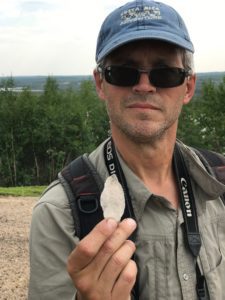Tours
Our staff will guide you on unique tours of the area focusing on the wildlife, botany, geography, and the history of this unique wilderness.
Aboriginal peoples from different Indigenous Nations have long inhabited and subsisted off this unique and amazing land!
History abounds in this area since the last glacier receded. This area was deglaciated around 6000 B.C. Glacial Lake Agassiz dominated the geology of the area but by 4000 B.C. with Agassiz receding, the forest/tundra line had progressed northward and stabilized at a position fairly current to today’s positions.
The first known people to inhabit the area were the Western Plano who moved throughout central Canada and the Northern U.S. in search of food and game around an estimated 4000 B.C. The next group to inhabit the area were the Shield Archaic people who evolved from the Northern Plano and traveled Manitoba from 300 B.C to 1000 B.C. The final group was the Taltheili Shale Tradition arriving from Northern B.C. and the Yukon Territory around 750 B.C. By 600 A.D.,

Dr. Brian Kotak with a spear head
they had introduced bows and arrows along with stone points. All these groups were nomadic tribes following the game, usually bison to the South and caribou to the North, as the animal herds moved. The Taltheili were proto-Athapaskans, the forerunners of the early Dene, one of the two local aboriginal groups who utilize the North Seal area to this day.
The remoteness of the area has precluded extensive archeological study but a few have been done. Dr. Ronald Nash visited the area in early 70’s. He found several sites on Egenolf Lake indicating concentrated winter hunting camps there as the caribou migrated south.
Twenty-two prehistoric sites were found on Egenolf and the nearby Robertson esker. Another more recent site was carbon-dated at 1490 A.D. The sites were not permanent sites but seasonal hunting camps showing many years of use. The key to the area was the unique and extensive esker system running through it. The aboriginal peoples’ made their use a staple as they pursued their winter hunting of the caribou herds as they migrated South. In 1996, archaeologist Virginia Petch and her team focused their study on the Robertson Esker, Manitoba’s largest and most famous, which runs over 120 miles through the heart of our area from South to North, stretching into Nunavut. Their search included where the North Seal intersects Egenolf and Blackfish Lakes and they found twenty new archaeological sites including some ancient portage markings. Some sites are indicated at over 2000 years old. We continue to find artifacts thru today.
Others have traveled the area since the first Aboriginal peoples, especially the great fur traders and explorers including Samuel Hearne. Egenolf itself is named after Father Egenolf, a Catholic priest famous to this area for his fluent Chipeweyan and Cree and penchant for traveling the entire North Seal River system in freighter canoes as he tended to his flock.

Today, the North Seal area and Northern Manitoba Sub-Arctic is where three great First Nations peoples intersect in their use of the land- The Dene, the Cree, and at the very northern edge, the Inuit, as they follow the caribou herds they subsist on. Today they travel the eskers and lakes with snowmobiles instead of dog sleds as the caribou repeat their ancient migration routes from thousands of years ago.
In a land all consider special- land of the eskers, the land of the deer, ‘ the Land of Little Sticks.’
Today, these same people whose ancestors first followed the caribou across this land help make Ganglers Canada’s #1 lodge as they guide you to an incredible experience.
Our staff will guide you on unique tours of the area focusing on the wildlife, botany, geography, and the history of this unique wilderness.
Hike the historic Robertson Esker and see artifacts and portage markers dating back over 2,000 years. Habitation of this land by ancient people dates back to pre-history 8,000 years ago. We are constantly finding new artifacts and sites every year and you may even discover one yourself!
Learn about the amazing Indigenous peoples who have called this wilderness home for thousands of years. Many of our guides are direct descendants who still hunt, fish, and trap this land as their ancestors did thousands of years ago.
Gangler’s Sub-Arctic is host to the highest concentration of Sand eskers in North America, left from the last glaciers 8,000 years ago. Their distinctive physical attributes give the area a unique beauty unlike anything you may have ever encountered. Visit our Erratics, huge boulders transported Northwards over 300 miles during the last ice age.
We are constantly sharing the wildlife, botany, geography, and history of this unique wilderness. Learn about local plant life the First Nations Peoples used for food sources and medicines. Indulge yourself in the ancient heritage of a land many are not aware even exists.
Courage Lake mini-lodge – an amazingly remote and unique setting. The Tundra is vastly different terrain from the North Seal area, home to different flora and fauna, and a key thoroughfare to the annual caribou migration in the Fall.
From the moment you step off the plane and onto our private runway you’ll sense our difference.
Ganglers have a simple core belief – It is an honor when a guest chooses to visit their lodge and they will not disappoint them!
Stay up to date with all our news and specials through our spam free Newsletter.